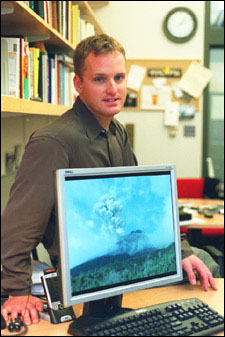Computer scientists develop wireless way to monitor volcanoes
Nanotechnology called into service for seismologists, officials, and area residents
A rumbling South American volcano has gone wireless: Computer scientists at

Harvard University have teamed up with seismologists at the University of New Hampshire and University of North Carolina to fit an Ecuadorean peak with a wireless array to monitor volcanic activity. The sensors should help researchers, officials, and local residents understand and plan for eruptions of Tungarahua, one of Ecuador’s most active volcanoes in recent years.
The researchers installed the wireless network on Tungarahua and captured 54 hours of data during a recent trip to the 5,016-meter mountain. The wireless system could eventually replace the wired sensors now used on Tungarahua and many other volcanoes.
“Systems used to monitor volcanic activity rapidly capture huge amounts of data,” says Matt Welsh, assistant professor of computer science in the Division of Engineering and Applied Sciences at Harvard. “The wired systems now used to monitor Tungarahua and other volcanoes are expensive, quickly exhaust batteries, and force people to trek up the slopes of a volcano every few days to retrieve the data that has accumulated.”
Welsh and his colleagues fitted Tungarahua with a network of five tiny, low-power wireless sensor nodes equipped with a special microphone to monitor infrasonic (low-frequency acoustic) signals emitted during eruptions. Each runs on two AA batteries, is sealed in a waterproof container the size of a soap dish, and transmits data automatically to an observation post more than 5 miles away down the mountain.
Often rumbling and spewing ash and hot gas numerous times each day, Tungarahua ranks among Ecuador’s most threatening volcanoes. In 1999 the entire town of Baños, in Tungarahua’s shadow, was evacuated for several months after observations led scientists and government officials to believe, incorrectly, that a major eruption was imminent.
Wireless sensor networks represent a new kind of computing platform. They
‘Our work indicates that wireless systems can be used to follow long-term trends in volcanic activity that are of great interest to researchers.’
– Matt Welsh, Assistant Professor
consist of small, low-power, wireless devices merging sensors with a small amount of computing power and storage. Sensor networks have been explored for applications such as habitat monitoring, medical care, and seismic analysis of structures; this effort is believed to be the first such application of wireless sensor networks to volcanic monitoring.
“This is a proof-of-concept that wired systems for monitoring volcanic activity can be replaced with wireless arrays,” Welsh says. “Specifically, our work indicates that wireless systems can be used to follow long-term trends in volcanic activity that are of great interest to researchers. This long-term observation entails copious amounts of data that is difficult to obtain with wired monitoring systems. Seismologists are very excited about the possibilities here.”
Seismologists and volcanologists use both seismic and infrasonic signals to monitor volcanic activity. Seismometers provide information on seismic waves propagating through the earth, but are poorly suited to discriminating eruptions from other activity such as earthquakes or mining operations. Infrasound waves, with a wavelength of less than 20 hertz, are characteristic of explosions and provide additional information not available with seismic monitoring.
Welsh and his colleagues now plan to develop a wireless seismometer to augment their infrasound array. The researchers also intend to deploy a larger network of some 20 nodes on Tungarahua, and may place wireless sensor networks on several other active volcanoes.
Welsh’s colleagues on this project are Geoff Werner-Allen at Harvard, Jeff Johnson at the University of New Hampshire, Mario Ruiz at the University of North Carolina and the Instituto Geofísico of the Escuela Politecnica Nacional in Ecuador, and Jonathan Lees at the University of North Carolina.




